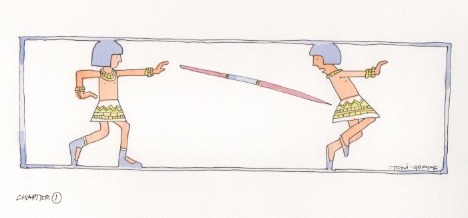THE AGRICULTURAL REVOLUTION
The Neolithic Agricultural Revolution
The development of a structured society, a more settled population and the growth of agriculture changed the pattern of human exercising to the more mundane work associated with husbanding animals and sowing, creating and harvesting crops. The numerous demands of growing food and raising cattle meant a lot of chores and a lot of daily labour for farmers. These tasks were largely repetitive, and required a very limited range of movement. At the same time, the need for performing a variety of complex movements — running, balancing, jumping, crawling, climbing — greatly diminished. Such movements were rarely performed in a farm environment, or were performed in much simpler ways; for example, climbing a ladder is safer and more constrained and predictable than climbing trees.
With a more secure food source, there would have been more spare time for fun with games and sports, helping muscles to stay in shape even when not so vital for survival. Early forms of organised exercise would have been used to keep the tribe in battle-ready physical shape.
Early games
Games as recorded by the ancient Egyptians and Greeks laid emphasis on such activities as running and javelin throwing which would have contributed to this. Egyptian pharaonic carvings and paintings show that they included javelin throwing, running, swimming, wrestling, rowing and even a primitive form of hockey. Running is recorded as one way of increasing readiness for battle and included distances of up to 60 miles.
The original Olympic Games were staged in 776 BC and included running, jumping, discus throwing, wrestling, boxing, chariot racing and the first pentathlon. For the Greeks and Romans exercise was also regarded as a part of the culture of attaining physical perfection and as an aid to good education – “mens sana in corpore sano” (Healthy mind in healthy body).
The body beautiful
Exercise at this time would also have been a means to an end for contestants but I suspect that such sports would have been mainly pastimes of the strong, the fast and the talented. Even so, several early civilisations recognised exercise as an admirable pursuit including China with tai chi and India with yoga. Running was a prominent feature of religious and daily life for the Kenyan Masai and the American Indians. Several Greek writers and physicians including Herodotus (c. 480 BC), Hippocrates (c. 400 BC) and Galen (c. 150 BC) extolled the preventive therapeutic benefits of physical activity – “Eating alone will not keep a man well; he must also take exercise.” However the idea of the general public taking exercise to maintain health and fitness is a relatively recent phenomenon. I doubt whether the average ancient Greek or Roman citizen would have performed recreational exercise as an aid to improving physical fitness.
The Dark Ages
The end of the Roman Empire and the arrival of the “dark ages” saw an end to the culture of the body beautiful. The spread of Christianity brought a belief that the body is sinful – it was the mind and preparation for the afterlife which predominated – though physical exercise remained very much a necessity for the peasants who laboured in the fields and at their various crafts. Hunting was a popular with the upper classes and was regarded as form of work, bringing food to the table. If they exercised otherwise, it was to be prepared for the exertions of combat. As the middle ages developed, jousting became another pastime for the rich. The common man took to wrestling and early forms of ball game.
PS
I have told you previously about the startling ability of weight loss to cure type 2 diabetes. One of the authors of the study which first showed this has now written as book about it:
“Reversing Type 2 Diabetes”. It is a must read for all type 2 diabetics and for those diagnosed as “pre-diabetic”
Subscribe to the blog
Categories
- Accelerometer
- Alzheimer's disease
- Blood pressure
- BMI
- Cancer
- Complications
- Coronary disease
- Cycling
- Dementia
- Diabetes
- Events
- Evidence
- Exercise promotion
- Frailty
- Healthspan
- Hearty News
- Hypertension
- Ill effects
- Infections
- Lifespan
- Lipids
- Lung disease
- Mental health
- Mental health
- Muscles
- Obesity
- Osteoporosis
- Oxygen uptake
- Parkinson's Disease
- Physical activity
- Physical fitness
- Pregnancy
- Running
- Sedentary behaviour
- Strength training
- Stroke
- Uncategorized
- Walking



Great blog, Chris